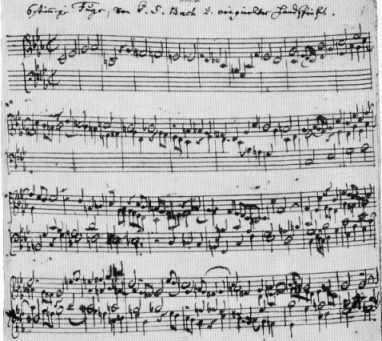
Part 4: Conclusion

Now, we are at the end of our musical journey, to be resumed next time,
when Bach takes us on an even longer journey called the Art of the Fugue.[1]
In our journey, we have learned from Bach how we can construct a series
of beautiful, yet thought-provoking compositions, starting from one musical
subject, and developing it by submitting it to various principles of musical
change. These transformations, which we also performed with geometrical shapes,
in order to better visualize them, were changes of time, position, and
directionality:
time displacement –- start later
time elasticity – augmentation and diminution
placement – at the octave, fifth or other interval
directionality – backwards and forwards
inversion – mirror image: upwards and downwards
modulation – winding spiral tonal ascension
These, then, are the musical tools which Bach has shown you, and
countless generations of students, how to use, to be able to construct a
dynamically developing, yet unified musical composition , where a single musical
idea is turned this way and that, in order to explore the pregnant-possibilities
it presents to a creative musical genius.
By solving of Bach's puzzle canons,
you have re-lived a Socratic method for creating music. More fundamentally, by doing so, you are able to explore the creative
power of human cognition itself.

The beginning of the 6-voiced Ricercar, in Bach's own hand.
And, not only Bach, but great composers who looked to Bach's spirit as their muse, paid homage to him by writing music with the Musical Offering as a metaphoric motiv. In a recent article entitled, "Music: Science or Fantasy?," Lyndon LaRouche points, yet again, to the quotations of Bach's Musical Offering from the very first bars of Mozart's piano sonata K. 475, written in 1785, three years after Mozart's intensive study of Bach at Gottfried van Swieten's weekly salon ; and "Beethoven's own frequently referenced, Promethean reflection of Mozart's reflection of Bach's Musical Offering, as this aspect of Mozart's K. 475 serves as a crucial transition to the empyreal, in the measures 20-49 of Beethoven's 111, where Mozart is quoted to crucial effect, in Beethoven's measures 38-49." (See also articles below for a discussion of the C-minor dialogue between Bach, Mozart and Beethoven.)
I hope that our journey, with Bach as guide, has stirred up your own
creative juices, and that you are now better equipped to make many journies
through your own compositions, while keeping Bach's playful, ironical smile in
your mind.

[1]
There, during the last of an even more elaborate series of fugues, the guide
posts suddenly end after the third fork in the road – in the midst of
Bach's development of the third of a (thought-to-be) projected four subject
fugue. This third subject is based on Bach's very own name! The theme
consists of the notes "B-A-C-H" (with "B" being "B
flat" in the German termonology, and "H" being
"B").
For
further reading:
‘Thinking Through Singing’: The Strategic Significance of J.S. Bach’s A Musical Offering, by David Shavin, Fidelio Vol. IX , No, 4. Winter 2000.
This article, by David Shavin, of the Schiller Institute in the US, both describes the political background of J.S. Bach, who in the tradition of Leibniz, attempted to get Frederick the Great out of the clutches of the Enlightenment, and discusses Bach's music.
It is best to look at Shavin's description of some of the puzzle canons after you work on them yourself, as he "gives it away."
Canons of the Musical Offering, Timothy A. Smith, has both the enigma canons, and the description of the solutions visible immediately thereafter. Again, don't look until you have tried to solve them yourself.
Musical Offering notes pdf link
In this file, the enigma canons are presented transposed to normal trebel
and bass clefs in the
first section, and the solutions in the second section.
Don't peak at the solutions before trying to solve the puzzles. The
ordering of the canons are different than here and on Timothy
Smith's homepage.
Mozart's 1782-1786 Revolution in Music, Fidelio, Winter 1992, by Lyndon LaRouche.
Bach, Mozart and the "Musical Midwife," New Federalist, by Michelle Rasmussen.
The "Royal Theme" from A Musical Offering in Dialogue among Bach, Mozart and Beethoven, Fidelio, 1997, by Ortrun Cramer, (has some of the puzzle canon solutions immediately visible).
Beyond Bach: Beethoven's Study of Bach's Works, Fidelio, Summer-Fall 2000, by Ortrun Cramer.